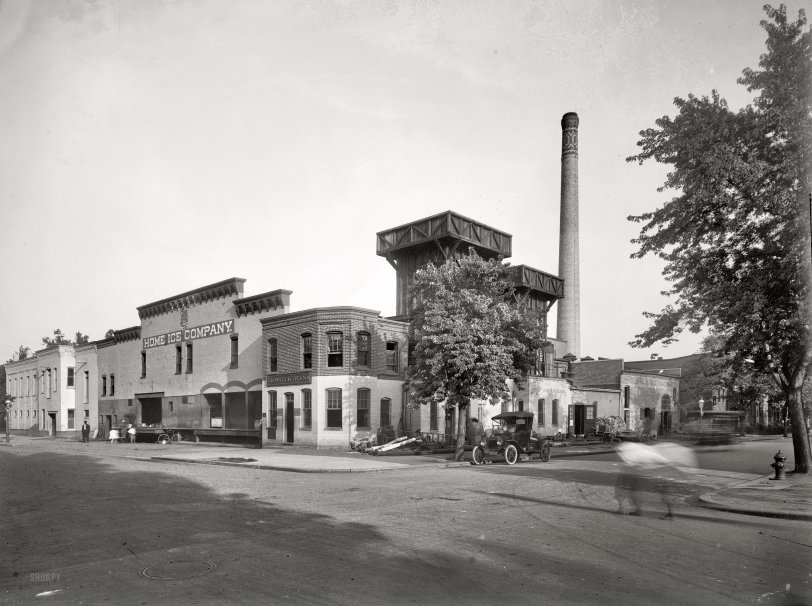


Framed or unframed, desk size to sofa size, printed by us in Arizona and Alabama since 2007. Explore now.
Shorpy is funded by you. Patreon contributors get an ad-free experience.
Learn more.

- Freeze Frame
- Texas Flyer wanted
- Just a Year Too Soon
- WWII -- Replacing men with women at the railroad crossing.
- Yes, Icing
- You kids drive me nuts!
- NOT An Easy Job
- I wonder
- Just add window boxes
- Icing Platform?
- Indiana Harbor Belt abides
- Freezing haze
- Corrections (for those who care)
- C&NW at Nelson
- Fallen Flags
- A dangerous job made worse
- Water Stop
- Passenger trains have right of way over freights?
- Coal
- Never ceases to amaze me.
- Still chuggin' (in model form)
- Great shot
- Westerly Breeze
- For the men, a trapeze
- Tickled
- Sense of loneliness ...
- 2 cents
- Charm City
- What an Outrage
- Brighton Park
Print Emporium
Home Ice: 1915

Circa 1915. "Home Ice Co." The Home Ice plant at 12th and V streets N.W. in Washington. National Photo Company Collection glass negative. View full size.
Cooling towers etc
Indeed those wooden structures were cooling towers to eliminate the heat removed from the water as it was turned into ice. Anhydrous ammonia was the preferred cooling agent when I worked in an ice plant, but sulfur dioxide, ether and several other refrigerants were used at various times and places.. The ice was made in steel tanks immersed in brine which circulated around the cooling coils and thus carried the cold around the steel tanks. The tanks held 300 pounds of water and to make the blocks clear, air was bubbled up through the center of the block as it froze. The air tubes were removed shortly before the ice froze completely or else they would have become frozen inside the ice block. After the air tubes were removed, the ice finished freezing, but this left a white "core" in the center of the ice block. Failure of one of the tubes to supply air would result in a completely white, but solid cake of ice which was not saleable.
And thanks to stanton-square, also..
For I relish the variety of print copy that finds its way into the comments through her research. They had some very distinct word usage in those long gone days that has disappeared over the years. And I'm a word guy as much as a photo lover. From the ad copy about Perfect Ice Cream I liked...
"Get quotations.
Phone or postal us."
[And I think our host, the photo god Dave, has a equivalent delight in fabricating the titles and witty wordplay in the follow on text. But I think that the best is found in the sometimes scathing, but mostly lighthearted, replies to commenters.]
Thanks Stinky
Great comment. Reminded me of my own love of the forlorn downtown of my hometown, which I was able to enjoy until the mid-1970s, when it all came down for urban renewal.
Ammonia
I came across a few articles in the Post archive about this place. It seems to have been a magnet for various industrial mishaps -- fires, explosions, ammonia leaks. One of them killed a horse.
Cooling Towers
The Home Ice Company was originally located at in the wharf district: 13½ and Water streets southwest. At that time, the late 1800s, ice was cut from New England ponds in winter, packed in sawdust, and transported to market by ship. Hence, the location of ice storehouses along waterfronts.
Around the turn of the century, ice manufacturing processes became commercially feasible and the ice business switched from transport-and-storage to commercial manufacturing. The Home Ice Company purchased this land (the southeast corner of 12th and V) in 1902, paying $30,000 for two large lots. The factory was designed by architect Frank H. Jackson and built by Arthur Cowsill.
There were several competing processes for the manufacture of ice, some involved pumped ammonia, others used tanks of salt-water brine. Someone in the know could probably look at this photo and determine what process was used here. Regardless of the process, I think the unique wooden towers would have functioned as cooling towers, probably using a rain of water to cool heat-exchange coils.
An Improvement?
I love everything about this photo. It is a perfect moment, captured perfectly. I particularly love the sense of "aloneness" on this street corner -- even with children and others present. It has a vague, ghostly atmosphere that I first discovered in downtown San Diego when I moved there in 1975. All of downtown west of Broadway had that same feeling: abandoned, alone, waiting. I spent much of my days off from work walking those streets, admiring those forgotten buildings and enjoying that special sense of "vacantness" and solitude. One brick building there stands out in my memory: several stories high, its neighbors torn down, leaving one full wall exposed. On it, in large and very faded letters was "Ya Gotta Wear Pants!" Even then, in 1975, a dark, dusty and run-down men's apparel store occupied the street-level, but not for much longer. Just as I was moving away in August of 1982, the city began an urban renewal project that I wouldn't return to see for 18 years. When I did return in 1998, that odd, ghostly and "waiting" area had been replaced by the "Gaslamp Quarter" and I walked though it with astonishment and a degree of awe but not with any joy. This photo of 12th and V conveys that very same "downtown San Diego feel" that I used to treasure. Looking at this GoogleMap link to 12th and V, I can see what's been irrevocably lost quite clearly.
Art & Industry
Look at the marvelous brickwork at the top of that chimney. Lovely!

























On Shorpy:
Today’s Top 5